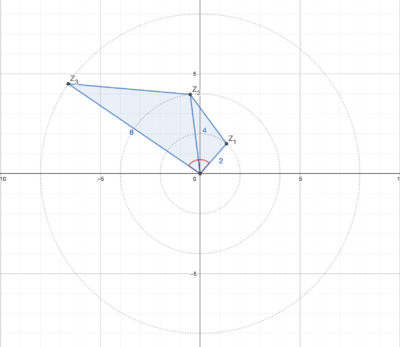Difference between revisions of "2024 AMC 12B Problems/Problem 12"
m (→Solution 1 (similar triangles)) |
|||
| Line 18: | Line 18: | ||
Additionally, we know that <math>\angle{Z_1OZ_2}\cong\angle{Z_2OZ_3}</math> (since every power of <math>z</math> rotates around the origin by the same angle.) We set these angles equal to <math>\theta</math>. | Additionally, we know that <math>\angle{Z_1OZ_2}\cong\angle{Z_2OZ_3}</math> (since every power of <math>z</math> rotates around the origin by the same angle.) We set these angles equal to <math>\theta</math>. | ||
| − | This gives us enough info to say that <math>\triangle{OZ_1Z_2}\sim\triangle{OZ_2Z_3}</math> by SAS (since <math>\frac{OZ_2}{OZ_1}=\frac{OZ_3}{OZ_2}=2</math>.) | + | This gives us enough info to say that <math>\triangle{OZ_1Z_2}\sim\triangle{OZ_2Z_3}</math> by SAS similarity (since <math>\frac{OZ_2}{OZ_1}=\frac{OZ_3}{OZ_2}=2</math>.) |
It follows that <math>[OZ_1Z_2Z_3]=[OZ_1Z_2]+[OZ_2Z_3]=[OZ_1Z_2]+2^2[OZ_1Z_2]=5[OZ_1Z_2]</math> as the ratio of side lengths of the two triangles is 2 to 1. | It follows that <math>[OZ_1Z_2Z_3]=[OZ_1Z_2]+[OZ_2Z_3]=[OZ_1Z_2]+2^2[OZ_1Z_2]=5[OZ_1Z_2]</math> as the ratio of side lengths of the two triangles is 2 to 1. | ||
Revision as of 01:45, 14 November 2024
Problem
Let ![]() be a complex number with real part greater than
be a complex number with real part greater than ![]() and
and ![]() . In the complex plane, the four points
. In the complex plane, the four points ![]() ,
, ![]() ,
, ![]() , and
, and ![]() are the vertices of a quadrilateral with area
are the vertices of a quadrilateral with area ![]() . What is the imaginary part of
. What is the imaginary part of ![]() ?
?
![]()
Diagram
Solution 1 (similar triangles)
By making a rough estimate of where ![]() ,
, ![]() , and
, and ![]() are on the complex plane, we can draw a pretty accurate diagram (like above.)
are on the complex plane, we can draw a pretty accurate diagram (like above.)
Here, points ![]() ,
, ![]() , and
, and ![]() lie at the coordinates of
lie at the coordinates of ![]() ,
, ![]() , and
, and ![]() respectively, and
respectively, and ![]() is the origin.
is the origin.
We're given ![]() , so
, so ![]() and
and ![]() . This gives us
. This gives us ![]() ,
, ![]() , and
, and ![]() .
.
Additionally, we know that ![]() (since every power of
(since every power of ![]() rotates around the origin by the same angle.) We set these angles equal to
rotates around the origin by the same angle.) We set these angles equal to ![]() .
.
This gives us enough info to say that ![]() by SAS similarity (since
by SAS similarity (since ![]() .)
.)
It follows that ![]() as the ratio of side lengths of the two triangles is 2 to 1.
as the ratio of side lengths of the two triangles is 2 to 1.
This means ![]() or
or ![]() as we were given
as we were given ![]() .
.
Using ![]() , we get that
, we get that ![]() , so
, so ![]() , giving
, giving ![]() .
.
Thus, ![]() .
.
~nm1728
See also
| 2024 AMC 12B (Problems • Answer Key • Resources) | |
| Preceded by Problem 11 |
Followed by Problem 13 |
| 1 • 2 • 3 • 4 • 5 • 6 • 7 • 8 • 9 • 10 • 11 • 12 • 13 • 14 • 15 • 16 • 17 • 18 • 19 • 20 • 21 • 22 • 23 • 24 • 25 | |
| All AMC 12 Problems and Solutions | |
The problems on this page are copyrighted by the Mathematical Association of America's American Mathematics Competitions. 










